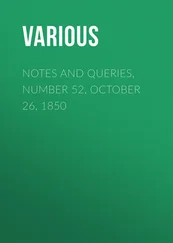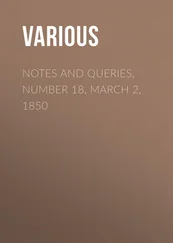Various - Notes and Queries, Number 204, September 24, 1853
Здесь есть возможность читать онлайн «Various - Notes and Queries, Number 204, September 24, 1853» — ознакомительный отрывок электронной книги совершенно бесплатно, а после прочтения отрывка купить полную версию. В некоторых случаях можно слушать аудио, скачать через торрент в формате fb2 и присутствует краткое содержание. Жанр: foreign_antique, periodic, foreign_edu, на английском языке. Описание произведения, (предисловие) а так же отзывы посетителей доступны на портале библиотеки ЛибКат.
- Название:Notes and Queries, Number 204, September 24, 1853
- Автор:
- Жанр:
- Год:неизвестен
- ISBN:нет данных
- Рейтинг книги:3 / 5. Голосов: 1
-
Избранное:Добавить в избранное
- Отзывы:
-
Ваша оценка:
- 60
- 1
- 2
- 3
- 4
- 5
Notes and Queries, Number 204, September 24, 1853: краткое содержание, описание и аннотация
Предлагаем к чтению аннотацию, описание, краткое содержание или предисловие (зависит от того, что написал сам автор книги «Notes and Queries, Number 204, September 24, 1853»). Если вы не нашли необходимую информацию о книге — напишите в комментариях, мы постараемся отыскать её.
Notes and Queries, Number 204, September 24, 1853 — читать онлайн ознакомительный отрывок
Ниже представлен текст книги, разбитый по страницам. Система сохранения места последней прочитанной страницы, позволяет с удобством читать онлайн бесплатно книгу «Notes and Queries, Number 204, September 24, 1853», без необходимости каждый раз заново искать на чём Вы остановились. Поставьте закладку, и сможете в любой момент перейти на страницу, на которой закончили чтение.
Интервал:
Закладка:
Various
Notes and Queries, Number 204, September 24, 1853 / A Medium of Inter-communication for Literary Men, Artists, Antiquaries, Genealogists, etc
Notes
EXTINCT VOLCANOS AND MOUNTAINS OF GOLD IN SCOTLAND
It is by some supposed that the Hill of Noth, in the parish of Rhynie, Aberdeenshire, had at one time been a volcano in full operation: others, again, maintain that the scoria found on and in the neighbourhood are portions of a vitrified fort, which had at one time stood on its summit. I am not aware that the matter has been investigated since our advancement in the science of geology has enabled us to have a more intimate knowledge of these things than formerly. The last statistical account of Scotland has suffered severely in its Aberdeenshire volume, in consequence of the temporary deposition of the "seven Strathbogie clergymen." The accounts of their several parishes were written by parties only newly come to reside in them, and who appear to have taken little interest in it; and Rhynie is one of these. Those who argue for its having been a volcano, say that it is very possible that there may at one time have been an electric or magnetic chain connecting it with subterranean fire in some other quarter of the world; and that by some convulsion of nature, the spinal cord of its existence had been broken, and life became extinct. This hypothesis has been acted on, in accounting for the earthquakes which occur at Comrie in Perthshire. The great storm which devastated the princely estates of Earl Goodwin in Kent (circa anno 1098), and now so well known to mariners as the Goodwin Sands, is also said to have laid waste the parish of Forvie, in Aberdeenshire. On the occasion of the great earthquake at Lisbon in 1755, a flock of sheep were drowned in their cot in the neighbourhood of Lossiemouth, near Elgin, by the overflowing of the tide, although far removed from ordinary high-water-mark. Assuming this mountain to have been a volcano, are there any others in Great Britain? While on the subject of mountains in that quarter, there is another which also demands attention for quite a different reason, the Hill of Dun-o-Deer, in the parish of Insch: a conical hill of no great elevation, on the top of which stand the remains of a vitrified fort or castle, said to have been built by King Gregory about the year 880, and was used by that monarch as a hunting-seat and where, combining business with pleasure, he is said to have meted out even-handed justice to his subjects in the Garioch. It has long been the popular belief that this hill contains gold; and that the teeth of sheep fed on it assume a yellower tinge, and also that their fat is of the same colour. Notwithstanding this, no attempt at scientific investigation has ever been made. The operations on the line of the Great North of Scotland Railway, now in progress in the immediate neighbourhood, may possibly bring something to light. This line passes for many miles through a country particularly rich in recollections of the "olden time"—cairns, camps, old chapels, druidical circles, sculptured stones, &c. and where ancient coins, battle-axes of all the three periods, urns and elf-arrow heads, Roman armour, &c., have been disinterred by the ordinary labours of the field. Within a short distance of its route lies the Hill of Barra, where the famous battle was fought, anno 1308, between the "Bruce" and the "Comyn;" the Bass at Inverary, the Hill of Benachie, with the remains of a fortification on its summit, said to have been erected by the Picts; the field of Harlaw, famed in song, where the battle was fought in 1411, in which Donald of the Isles was defeated. There are many traditional ballads and stories relating to Benachie and Noth. There is a ballad called "John O'Benachie" and another, "John O'Rhynie, or Jock O'Noth" and they do not appear in any collection of ancient ballads I have seen. It is said that long "before King Robert rang," two giants inhabited these mountains, and are supposed to be the respective heroes of the two ballads. These two sons of Anak appear to have lived on pretty friendly terms, and to have enjoyed a social crack together, each at his own residence, although distant some ten or twelve miles. These worthies had another amusement, that of throwing stones at each other; not small pebbles you may believe, but large boulders. On one occasion, however, there appears to have been a coolness between them; for one morning, as he of Noth was returning from a foraging excursion in the district of Buchan, his friend of Benachie, not relishing what he considered an intrusion on his legitimate beat, took up a large stone and threw at him as he was passing. Noth, on hearing it rebounding, coolly turned round, and putting himself in a posture of defence, received the ponderous mass on the sole of his foot: and I believe that the stone, with a deeply indented foot-mark on it, is, like the bricks in Jack Cade's chimney, "alive at this day to testify." Legendary lore and fabulous ballads aside, it would indeed be strange if something interesting to the antiquary does not turn up in such a mine as this. It is curious, however, that in all the operations antecedent to covering Great Britain with, as it were, a network of iron, so very few discoveries should have been made of any importance, either to the antiquary or geologist.
Abredonensis.THOMAS BLOUNT, AUTHOR OF "FRAGMENTA ANTIQUITATIS," ETC
Being on a visit to some friends on the confines of the county of Salop, bordering on Herefordshire, I took the opportunity long cherished of visiting the spot where lie the remains of the author of Boscobel; Fragmenta Antiquitatis, or Ancient Tenures of Land, and Jocular Customs of Manors, &c. , and copied the following inscription from his monument, in the chancel of the ancient church of Orleton in the latter county. I believe it has never been published; and although neither Note nor Query is connected with it, it may serve to fill up a corner in your valuable miscellany, and thus preserve from the oblivion of a retired country church, a memorial of one well known to the antiquarian world of literature. It is on a brass plate inserted in a stone monument against the wall of the chancel:
The village of Orleton is celebrated for a very large annual fair, which occurs on April 23; and a saying is connected therewith: "That the cuckoo always comes on Orleton fair-day;" which has doubtless arisen from the circumstance, that this "messenger of spring" generally arrives in this country by that day.
Читать дальшеИнтервал:
Закладка:
Похожие книги на «Notes and Queries, Number 204, September 24, 1853»
Представляем Вашему вниманию похожие книги на «Notes and Queries, Number 204, September 24, 1853» списком для выбора. Мы отобрали схожую по названию и смыслу литературу в надежде предоставить читателям больше вариантов отыскать новые, интересные, ещё непрочитанные произведения.
Обсуждение, отзывы о книге «Notes and Queries, Number 204, September 24, 1853» и просто собственные мнения читателей. Оставьте ваши комментарии, напишите, что Вы думаете о произведении, его смысле или главных героях. Укажите что конкретно понравилось, а что нет, и почему Вы так считаете.












